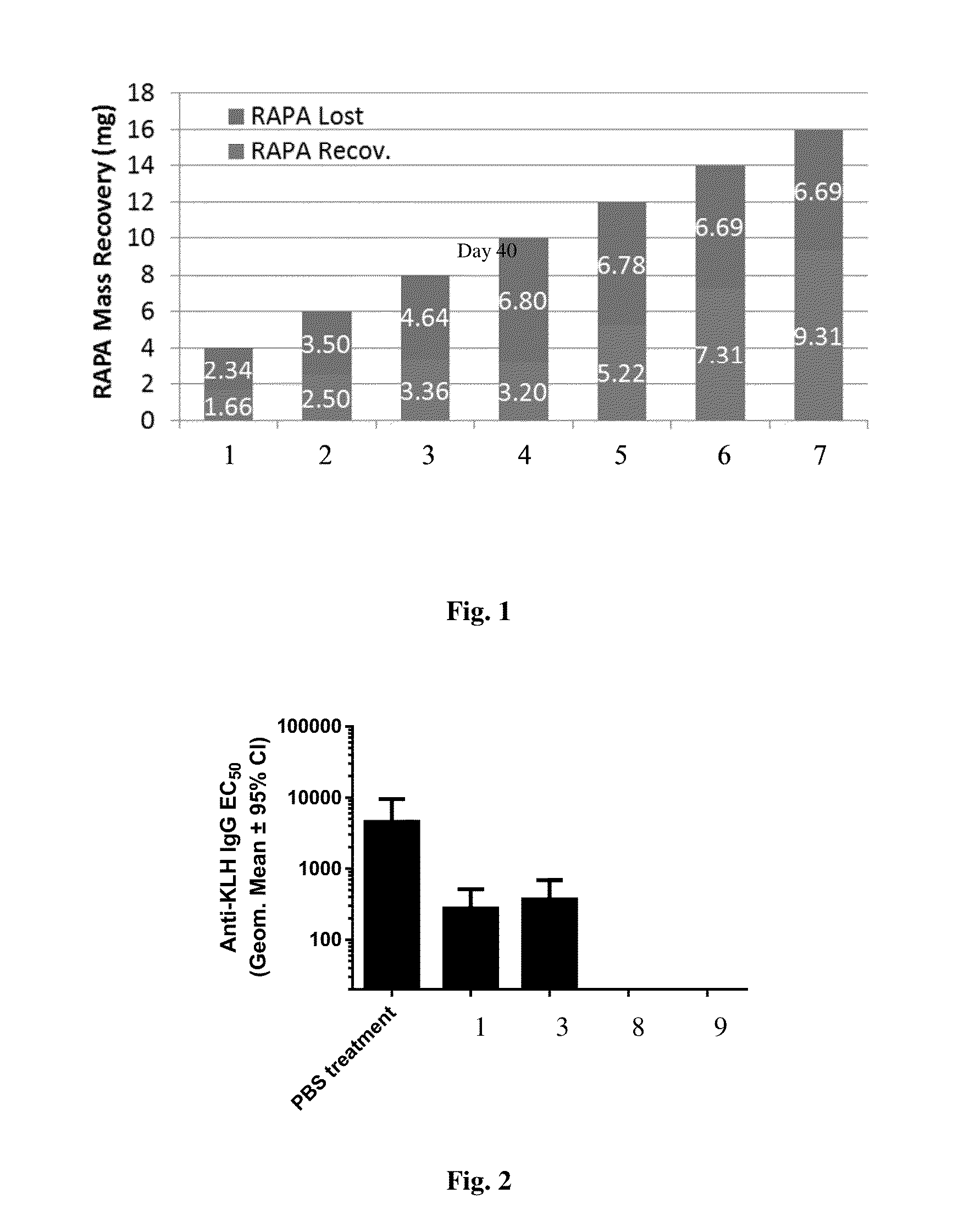Methods and compositions related to synthetic nanocarriers with rapamycin in a stable, super-saturated state
a technology of synthetic nanocarriers and rapamycin, applied in the direction of antibody medical ingredients, drug compositions, immunological disorders, etc., can solve the problems of synthetic nanocarriers, and achieve the effect of promoting immune tolerance and durable immune toleran
- Summary
- Abstract
- Description
- Claims
- Application Information
AI Technical Summary
Benefits of technology
Problems solved by technology
Method used
Image
Examples
example 1
Synthetic Nanocarriers with Super-Saturated Amounts of Rapamycin
[0124]Nanocarrier compositions containing the polymers PLGA (3:1 lactide:glycolide, inherent viscosity 0.39 dL / g) and PLA-PEG (5 kDa PEG block, inherent viscosity 0.36 dL / g) as well as the agent rapamycin (RAPA) were synthesized using an oil-in-water emulsion evaporation method. The organic phase was formed by dissolving the polymers and RAPA in dichloromethane. The emulsion was formed by homogenizing the organic phase in an aqueous phase containing the surfactant polyvinylalcohol (PVA). The emulsion was then combined with a larger amount of aqueous buffer and mixed to allow evaporation of the solvent. The RAPA content in the different compositions was varied such that the compositions crossed the RAPA saturation limit of the system as the RAPA content was increased. The RAPA content at the saturation limit for the composition was calculated using the solubility of the RAPA in the aqueous phase and in the dispersed nano...
example 2
Synthetic Nanocarriers with Super-Saturated Rapamycin Eliminates or Delays Antibody Development
[0126]Nanocarrier compositions containing the polymers PLGA (3:1 lactide:glycolide, inherent viscosity 0.39 dL / g) and PLA-PEG (5 kDa PEG block, inherent viscosity 0.36 dL / g) as well as the agent RAPA were synthesized using an oil-in-water emulsion evaporation method described in Example 1. The RAPA content in the different compositions was varied such that the compositions crossed the RAPA saturation limit of the system as the RAPA content was increased.
Calc. OverRAPADiameterSample IDSaturation (%)Load (%)(nm)1−502.5143314.91478218.516394813.5159
[0127]To assess the ability of the compositions to induce immune tolerance, mice were intravenously injected three times weekly with co-administered nanocarrier and keyhole limpet hemocyanin (KLH) and then challenged weekly with KLH only. The sera of the mice were then analyzed for antibodies to KLH after KLH challenge. The compositions made in the...
example 3
Synthetic Nanocarriers with Super-Saturated Amounts of Rapamycin
[0128]Nanocarrier compositions containing the polymers PLA (inherent viscosity 0.41 dL / g) and PLA-PEG (5 kDa PEG block, inherent viscosity 0.50 dL / g) as well as the agent RAPA were synthesized using the oil-in-water emulsion evaporation method described in Example 1. The RAPA content in the different compositions was varied such that the compositions crossed the RAPA saturation limit of the system as the RAPA content was increased. The RAPA content at the saturation limit for the composition was calculated using the method described in Example 1. For compositions containing the described PLA and PLA-PEG as the nanocarrier polymers, it was found that the RAPA solubility in the dispersed nanocarrier phase was 8.4% wt / wt. The following formula may be used to calculate the RAPA content at the saturation limit for the composition:
RAPA content=V(0.008cPVA+0.084cpol)
where cPVA is the mass concentration of PVA, cpol is the comb...
PUM
| Property | Measurement | Unit |
|---|---|---|
| diameter | aaaaa | aaaaa |
| diameter | aaaaa | aaaaa |
| diameter | aaaaa | aaaaa |
Abstract
Description
Claims
Application Information
 Login to View More
Login to View More - R&D
- Intellectual Property
- Life Sciences
- Materials
- Tech Scout
- Unparalleled Data Quality
- Higher Quality Content
- 60% Fewer Hallucinations
Browse by: Latest US Patents, China's latest patents, Technical Efficacy Thesaurus, Application Domain, Technology Topic, Popular Technical Reports.
© 2025 PatSnap. All rights reserved.Legal|Privacy policy|Modern Slavery Act Transparency Statement|Sitemap|About US| Contact US: help@patsnap.com



